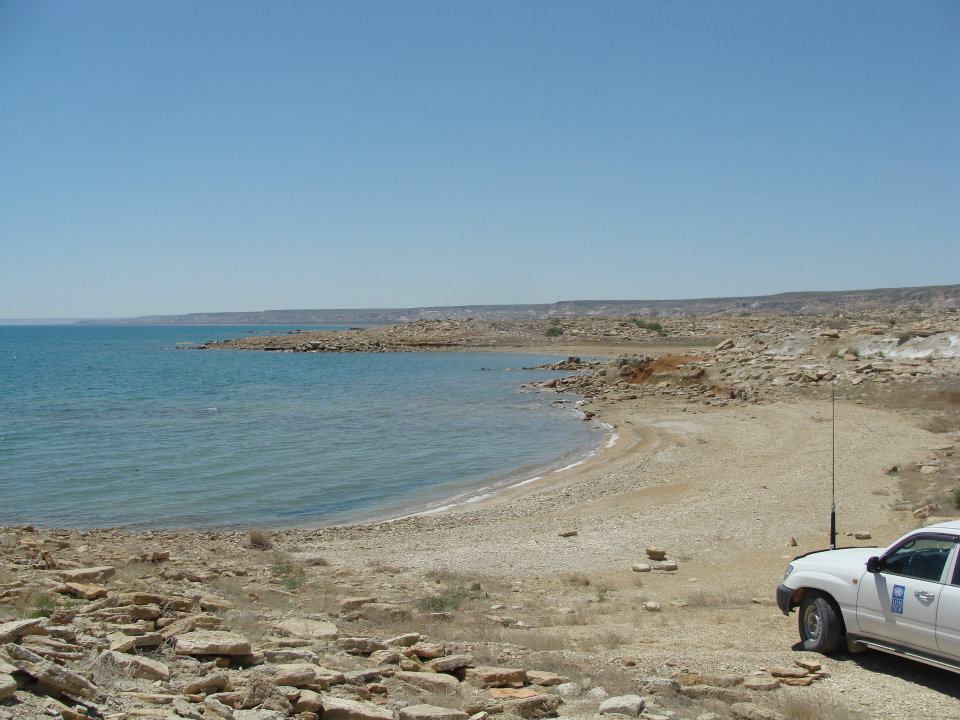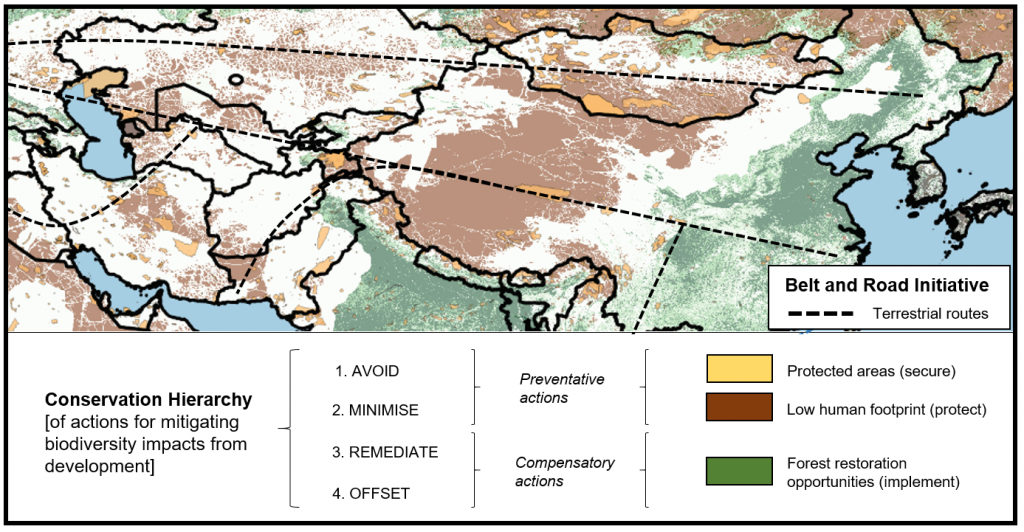CURRENT AND FORTHCOMING RESEARCH
Resurrection Island: safeguarding biodiversity around the former Aral Sea
The Aral Sea and adjacent Ustyurt plateau is one of the world’s starkest examples of human activities leading to landscape-scale environmental destruction, dramatic biodiversity loss, and economic collapse – with disastrous ramifications for human health and wellbeing. A final hold-out for nature in the region is so-called ‘Resurrection Island’ in the middle of the former Aral Sea; now a peninsula, it harbours unique, undisturbed biodiversity. But alongside the challenge of extremely rapid local climate change, wildlife here is currently newly threatened by looting and poaching.
We are working with partners across the region to develop an integrated approach towards the recovery of the social-ecological system around the former Aral Sea, through nature-based solutions, and using Resurrection Island as our flagship. Our work will involve a combination of primary research (field surveys and remote observation to track wildlife and ecological restoration trajectories, landscape-scale mapping of land use change and restoration opportunities, structured surveys to explore the preferences of actors in the social-ecological system) and capacity building, working with scientists, businesses, and public sector organisations.

Accurate large-scale prediction of biodiversity impacts
One of the most important environmental challenges of our time is to better quantify, model and predict the impacts of economic development activities on nature. Only if this is done to a greater degree of accuracy will we be able to fully mitigate those impacts.
Global levels of biodiversity are declining at an alarming rate, with severe implications for human wellbeing. Economic development activities are amongst the leading mechanisms for global biodiversity loss. Yet there is currently no solid empirical basis for quantifiably predicting the typical impacts of specific development projects. This is a problem since decision-makers require an accurate assessment of the likely biodiversity impacts of any given development project when determining whether it should proceed, and a robust basis on which to predicate impact mitigation measures.
We are seeking to explore this topic, combining: (i) newly collated global datasets on impact mitigation actions; (ii) analysis of remotely-sensed (satellite) data; (iii) machine learning algorithms designed to extract available online biodiversity data; and, (iv) direct ecological surveys in the field.

Machine learning for automated evaluation of the biodiversity risk associated with different corporations, as the basis for financial investment decisions.
Launched in 2020, the Benchmark for Nature will power the development of structured, rigorous, and practically useful frameworks for assessing investor impacts on living nature. It is a collaboration between the University of Oxford, the Royal Foundation of the Duke & Duchess of Cambridge’s United for Wildlife Financial Task Force, and the FNZ Group, a leading financial technology platform and member of the Task Force. The project’s legal partner is London law firm Mishcon de Reya, through its innovative sustainability advisory practice, Mishcon Purpose. Benchmark for Nature encompasses two key actions: (1) the development of a robust science-based reporting and assessment framework to evaluate the relative impacts of investments on living nature; and, (2) the drafting of a Preliminary Standard for Nature-related Financial Disclosures, a science-based framework enabling consistent nature-related financial risk disclosure.

SUPERB
Systemic solutions for upscaling of urgent ecosystem restoration for forest-related biodiversity and ecosystem services (SUPERB) is a major new project (2021 – 2025) working with partners across Europe, developing the technical basis for delivering widespread forest restoration and then putting it into practice. The focus is on reforestation and forest restoration for biodiversity and as a nature-based solution to climate change.
This project involves a consortium of 36 scientific/practitioner partners all over Europe, led by the European Forest Institute. SUPERB aims to restore European forest landscapes by creating an enabling environment for implementation of forest restoration and adaptation. SUPERB will build on the vast practical knowledge and lessons learned of successful and unsuccessful forest restoration activities, synthesizing them for action. We will connect with restoration experts, including practitioners with decades of experiences . This practical knowledge will be underpinned by a compilation of highly relevant scientific knowledge including economic, governance, forest management, and climate change adaptation aspects. Concrete restoration actions will be carried out in 12 large-scale demonstration areas, across 13 different countries. These areas not only represent the diversity of stressors on European forests and various restoration actions, but also, consider the whole social-ecological system including natures contributions to people.

The Mitigation and Conservation Hierarchy | Development of a technical framework for mapping and monitoring progress towards nature conservation targets, for a range of actors, across multiple spatial scales.
The Mitigation and Conservation Hierarchy expands on the established mitigation hierarchy approach in two key ways:
(1) It can be used by sectors where the mitigation hierarchy has not yet been widely applied. This includes e.g. natural resource exploitation (e.g. agriculture, fisheries, forestry), where the impacts are sometimes geographically dispersed through long, complex value chains.
(2) It adds a conservation element that goes beyond mitigating impacts, to encompass any activities affecting nature. This means that conservation actions to address historical, systemic and non-attributable biodiversity loss can be accounted for in the same framework as actions to mitigate specific impacts. See: https://conservationhierarchy.org/.

ESTABLISHED RESEARCH THEMES
Net outcomes
Our ‘net outcomes’ research explores drivers of positive and negative biodiversity change, particularly in relation to quantifying empirical outcomes of net outcome policies, the choice of appropriate metrics, key sources of stochasticity, and climate change. Strands include:
- Biodiversity measurement
- Quantification of biodiversity outcomes
- Demonstration of ecological equivalence
- Impact mitigation (including biodiversity offsets)
- Net outcomes in the context of climate change

System dynamics
Systems thinking is crucial to our work, both in terms of tracking trends and in terms of mechanistic processes underlying the ways in which ecosystems change through time. Interests include:
- Counterfactual evaluation and reference frames
- Social-ecological systems dynamics
- Agent-based modelling
- Influence of environmental change (especially climate change) on biodiversity

Spatial analyses
Conservation science is inextricably linked to spatial analysis. We use a combination of open source and proprietary GIS software to collate and analyse spatial datasets, and to implement structured conservation planning algorithms. For example:
- Remote sensing
- Systematic conservation planning
- Spatial statistics

Biodiversity and large organisations
Successful achievement of current global conservation objectives necessitates direct and meaningful engagement with large organisations. We seek to contribute towards this not only through Wild Business but also through research on the topic of ‘business and biodiversity’, such as the aggregated biodiversity impacts and greenhouse gas emissions of multinational corporations and other large organisations.


Field ecology
Nature conservation rests upon a good understanding of how nature works, which rests partly upon experience out in the field. We base our other research themes upon direct biodiversity observation and monitoring, including:
- Biodiversity monitoring
- Impact mapping
- Ground-truthing

Note: The copyright for all photos on this website belong to J. W. Bull unless otherwise stated

